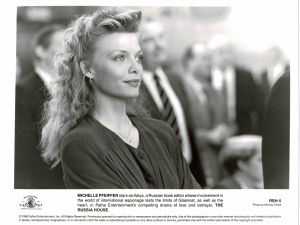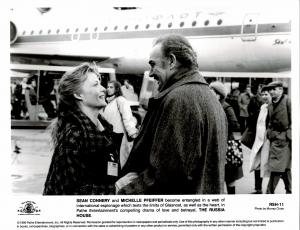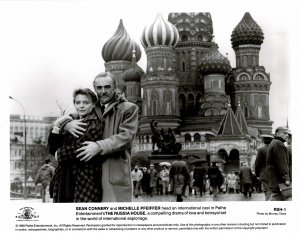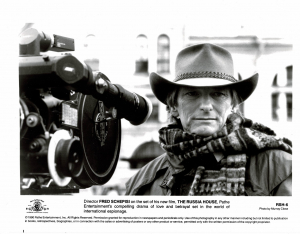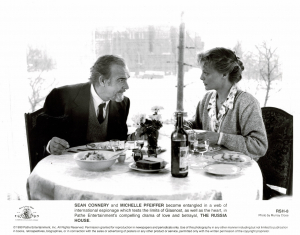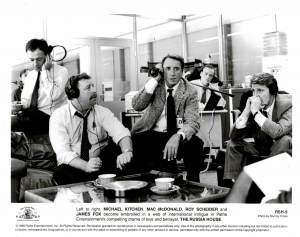The Russia House
THE RUSSIA HOUSE
Barley Blair is a British publisher who likes books, booze and jazz.
And that’s about as complicated as his life has been. Until now.
A brilliant Soviet scientist whom the publisher met at a writer’s dinner party in the Russian countryside, attempts to smuggle a manuscript to Barley; a manuscript which, if published in the West, could dramatically alter the global balance of power, if not the course of world history itself.
The courier is a beautiful Soviet woman named Katya. The cold communism of the Russia into which she was born is giving way to glasnost and perestroika. Yet despite the new openness, there remain those who seek to preserve the status quo of a cold war between the superpowers. Aware of the danger in acting as the intermediary, Katya risks her life, and that of her children, so that a measure of peace and understanding might somehow come to a troubled world.
When the manuscript falls into the hands of the West’s spymasters, Barley is pulled into a world of intrigue, risk and danger from which there may be no escape — a world in which love is the most dangerous risk of all.
Pathe Entertainment, Inc. presents THE RUSSIA HOUSE, a Fred Schepisi Film starring Sean Connery and Michelle Pfeiffer. Directed by Fred Schepisi and written by Tom Stoppard from the novel by John le Carre’, THE RUSSIA HOUSE also stars Roy Scheider, James Fox, John Mahoney and Klaus Maria Brandauer. The film is produced by Paul Maslansky and Fred Schepisi, with cinematography by Ian Baker and a musical score by Jerry Goldsmith, featuring Branford Marsalis.
Helining an all-star cast, producer/director Fred Schepisi calls THE RUSSIA HOUSE, “The dream ticket.”
The filmmaker, whose past work has included, among others, the films “A Cry in the Dark,” “Roxanne” and “Plenty” adds, “I do think movies these days have got to take you on a journey or an experience that’s special or different. This is a great sweep of a movie that has an intimacy at its core.”
Certainly one element which makes THE RUSSIA HOUSE unique is that it is the first major Hollywood film to be made in the U.S.S.R. that is not a co-production. It emerged as a result of a unique friendship that developed between Schepisi and director Elem Klimov, who headed the Soviet Filmmakers Union. The Soviet director steered the Westerner to the independent Russian-German company Corona, which provided guidance through the intricacies of a system gearing up to a more Western approach.
“The structure we worked out was that our Russian partners paid for everything in Russia and we put the equivalent amount into a film they want to make in the West,” explains Schepisi, who first read the galleys of John le Carres thriller back in February, 1989. Amazingly, just seven months later, on October 2, 1989, he was standing in Leningrad’s Palace Square, birthplace of the Revolution, looking at the Winter Palace of the Czars on a bitingly cold day and calling “action” on the multi-million dollar production.
The filming of THE RUSSIA HOUSE came at one of the most significant times in the history of the Soviet Union since the Revolution.
“When I went on my first location scout, it was incredible because I was there when they were making historic changes in the country,” recalls Schepisi.
“You could feel the excitement; there was uncertainty and worry.
“I thought John le Carre’s book was a real look at glasnost and the end of the cold war and a look at the people who should know better,” continuesSchepis “The spymasters of East and West are the people who should appreciate that the cold war is over, but they seem to want to perpetuate it to keep their jobs going.”
While glasnost in action is the underlying theme, THE RUSSIA HOUSE is also a powerful and persuasive East/West love story — subject matter which, before Gorbachev, would probably not have been filmed in the Soviet Union. “I think we very optimistic,” Schepisi adds. “It’s about a disillusioned character who meets people prepared to risk their lives to make changes for the good of mankind; it’s about a man meeting a woman who gives him the strength to rehabilitate himself.”
John le Carre4s best-selling novel upon which THE RUSSIA HOUSE is based was written for the screen by reknowned playwright Tom Stoppard.
“John le Carrgmay have flirted with the idea of writing the screenplay,” notes Schepisi, “but he wasn’t really sure that a novelist is the best person to write his own material for the screen.”
It was the author himself who suggested Tom Stoppard write the script based on his book. Not only does the Czechoslovakian-born Stoppard have the emigre sensitivity to the subject, but he is one of the foremost British playwrights whose works are eagerly sought by actors and theatregoers the world over. THE RUSSIA HOUSE marks Stoppard’s latest foray into film, having recently written the screenplay for Steven Spielberg’s acclaimed “Empire of the Sun,” as well as writing and directing the screen adaptation of his own play, “Rosencrantz and Guildenstern Are Dead.”
Following its enormous success in the West, the Russian translation of John le Carrels novel “The Russia House” was published almost exactly one year from the day the film began production in the Soviet Union. With unprecedented speed and despite a nationwide paper shortage, a first print run of 100,000 copies of the book became available in Russia on October 3, 1990, marking the first le Cane/novel to be published in Russia in hardcover.
Additionally, in the first of a two-part serialization, the prestigious and influential Russian magazine Inostrannava Literatura (Foreign Literature) published a portion of “The Russia House” in May, 1990. Soviet readers anxiously await the second installment, which is scheduled to run as soon as enough paper can be made available to the publication.
The film tells the story of Barley Blair (Sean Connery), a British publisher who becomes unwittingly embroiled in the world of espionage when a Soviet scientist (Klaus Maria Brandauer) attempts to put glasnost to the
test. Using the beautiful Katya (Michelle Pfeiffer) as his courier, the scientist smuggles his manuscript to the West, whereupon the information falls into the hands of Western spymasters. Their suspicion leads Barley
deep into a web of deceit, danger and unexpected desire in Mr. Gorbachev’s Russia.
“I had the galley proofs of John le Cards book, which I thought was terrific,” recalls Sean Connery, who first became aware of THE RUSSIA HOUSE while filming “The Hunt for Red October.”
“My character, Barley Blair, starts out as this boozy, saxophone playing publisher, whose whole life and situation is in chaos,” continues Connery. “The people he meets in Russia, and the experience of this moral dilemma with which he is faced, help connect him back, finally, to the world.”
Schepisi describes Connery’s character, the hero of THE RUSSIA HOUSE, as “certainly outside the system. I’m attracted to these characters because through them you can look at everything differently.”
For Michelle Pfeiffer, playing Katya in THE RUSSIA HOUSE was perhaps the most challenging role thus far in her career. “This is the toughest film I’ve ever done. I’ve done dialects before but here I’m playing somebody from a completely different culture. Russia is not an easy country to grasp, not an easy country to talk about.”
Interspersed with the action taking place in Russia are the scenes in the situation rooms in Washington and London, where the rest of the international cast assembles.
Producer Paul Maslansky was familiar with the exigencies, as well as the extraordinary benefits associated with film production in Russia, having previously worked in the Soviet Union on “The Red Tent,” the first Russian-Italian co-production, starring Sean Connery, and “The Bluebird,” for director George Cukor which starred Elizabeth Taylor.
“THE RUSSIA HOUSE is, in many ways, a ‘pioneer’ movie. It deals with themes and events never before filmed in the U.S.S.R.,” Maslansky notes.
Schepisi, in a memo to cast and crew their first week in Moscow, perhaps best summed up the rare experience of filming THE RUSSIA HOUSE, writing, “In a small way you are a part of history. We are the first people to be making a film, in this way, in this country. The people here are bending over backwards to help us, in ways that are almost alien to their upbringing. They are more than willing. They know that many high-level people are closely observing what is considered a bold experiment.
“In an era of glasnost, I believe it is important to make it work. We have a real chance to do something different and exciting.”
ABOUT THE PRODUCTION
Production began on October 2, 1989 in Leningrad, the first of several major international locations that would include Moscow, London, Lisbon and Vancouver.
Four and one half weeks of locations in Russia represented uncharted waters for the filmmakers Once the Soviet government granted the necessary permissions, however, the production received unique cooperation, filming wherever they wanted in a way that might not have been possible anywhere else in the world.
Leningrad, often called the Venice of the north, is one of Europe’s most elegant cities, with its neo-classical architecture and Russian baroque influences. Formerly St. Petersburg, then Petrograd, Leningrad was the birthplace of the Revolution in 1905. After Leningrad was besieged by the Germans during World War IT, a magnificent granite memorial to those who died was built in the Field of Mars, which the filmmakers chose as the location to film a crucial meeting between Barley (Sean Connery) and Dante (Klaus Maria Brandauer).
In Nevsky Prospekt, one of the main thoroughfares of Leningrad, the filmmakers shot in and among the crowds which lent further realism to those scenes. During the hectic week there, the crew often shot three separate locations in one day. Leaving Leningrad, the cast and crew took a special train on which they filmed a sequence while travelling to Moscow.
The differences between Leningrad and Moscow were readily apparent. As the capital of the Soviet Union, Moscow, a sprawling city of eight million, is dominated by solid architecture and Stalinist buildings, a far more oppressive look and feel than the vibrant, light-filled streets of Leningrad.
Red Square itself, under the watchful eye of the guards outside Lenin’s tomb, played host to the filmmakers one rainy day as sequences were filmed with Sean Connery and Michelle Pfeiffer walking across the Square in front of St. Basil’s Cathedral. Kremlin officials watched the proceedings from their offices above the Square.
Among the many film locations in and around Moscow were a few days at Peredelkino, the site of the dachas of the prestigious writers and artists.
On another day, filming took place in the nearby cemetary where Boris Pasternak, famed Russian poet and novelist (“Dr. Zhivago”), is buried.
A night spent shooting in the Moscow Metro was enlightening for the cast and crew. Not only were they able to witness Muscovites on their way home after a hard day’s work, but the Metro itself was chastening to the Western eye. Completely devoid of graffiti, litter and advertisements, the grand structure boasts spectacular art, sculpture, mosaic and chandeliers.
Outside the city, the unit travelled 45 miles northeast of Moscow to Zagorsk, also called the City of Churches, known for its fine treasure store of early Russian art, dating back to medieval times. A reduced unit shot for three days at the top of a bell tower in sub-zero temperatures, filming an involved scene between Barley (Sean Connery) and Katya (Michelle Pfeiffer).
The unit next moved to Kolomenskoye, the old country estate of the Czars which is perched on a commanding bluff above a long curve in the Moscow River. Used in THE RUSSIA HOUSE for the scene in which Barley and Katya picnic with her children, the park boasts examples of old wooden buildings from Peter the Great’s hut to a seventeenth century watchtower dismantled and brought there from Siberia. The tall white Church of the Ascension dates from the 1530s. The Czar had a throne in the upper gallery which allowed him to simultaneously “attend” the religious service while watching the military maneuvers and falconry in the fields across the river.
The 17th century church of the Kazan Icon of the Mother of God, with its distinctive blue cupolas, was the Czars’ domestic chapel, and was linked to the palace by an underground tunnel. Peter the Great spent most of his childhood here, and gave his royal protection to the park’s grove of ancient oak trees, which are now more than 800 years old.
Other sequences took the cast and crew out into the Moscow streets, to
the Ukraine Hotel with its characteristic Stalinesque architecture; to the spectacular Exhibition site close to the Memorial to Space Achievement; to apartment block high rises; into the restaurant of the National Hotel with its bird’s-eye view of Red Square; and into GUM itself, the world’s largest department store.
Of their experiences filming in Russia, Schepisi notes, “The Russians are lovely people. They have a warmth and humanity and they want to help.
Of course it’s difficult because we go about making a film in a very different way from the Russian way and a lot of adjustment to their ways of working was required. But the Russians were incredibly cooperative, helpful and willing”
Echoing Schepisi’s feelings, Maslansky says, “It was an untested area but it went as smoothly as any location could have have gone anywhere. We finished 26 days filming on time, on budget and without incident”
The crew moved to London for a 10-day shoot, mostly on Katya’s apartment set at Pinewood Studios, before moving on to Lisbon for the scenes involving Barley’s interrogation by British Intelligence and the CIA, and also the scenes of Barley’s Lisbon apartment Much of the time in Lisbon was taken up with interiors at the Lisbon House, an impressive building with a spectacular view over the rooftops of Lisbon and out to sea. In reality, the building houses the head office of Nissan’s Portugese operation.
After a hectic ten days in Lisbon, the crew moved back to England for scenes involving CIA agent Russell (Roy Scheider), British agent Ned (James Fox) and staff in the Situation Room which was actually a floor of Pathe House in Hammersmith, West London. The set was appropriately dressed with state-of-the-art computer banks, monitoring equipment and television sets.
The final ten days of shooting took place in Vancouver, Canada, for the scenes in which Barley Blair is interrogated at a mountain retreat on a beautiful island off the North American coast.
With a statement that might apply not only to the experience of filming in the Soviet Union, but to the state of affairs there as well, producer Maslansky concludes, “Nothing is easy in Russia, but everything is possible.”

